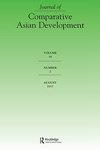Spatial Dimensions of Key Employment Outcomes in Indonesia
Q3 Social Sciences
引用次数: 5
Abstract
Abstract This paper gauges spatial inequality in Indonesia beyond the traditional focus on income and consumption by mapping a small subset of employment-related indicators in Indonesia disaggregated by provinces over time (1996–2011). It looks beyond the conventional indicators of unemployment rate such as formal employment, wage inequality, low-pay incidence and percentage of youth NEET (not in employment, education or training). Three observations stand out. First, while the unemployment rate continued to decline from 2005, regional variations were relatively high and showed an increasing trend. Second, the magnitudes of regional variations of indicators reflecting the quality of employment (e.g. formal employment and waged employment) were also high. Third, gender gaps in most of the employment-related indicators were declining but from very high levels. It is suggested that Indonesia should concentrate more on indicators reflecting the quality of employment with clear targets set, disaggregated into sub-national levels. For this, the evolution of spatial inequalities with regard to employment outcomes should be better and more regularly monitored.印度尼西亚主要就业成果的空间维度
本文通过绘制印度尼西亚按省份分类的就业相关指标的一小部分图(1996-2011)来衡量印度尼西亚的空间不平等,而不是传统的关注收入和消费。它超越了失业率的传统指标,如正式就业、工资不平等、低薪发生率和青年啃老族(未就业、未受教育或未接受培训)的百分比。有三点值得注意。首先,失业率从2005年开始持续下降,但区域差异较大,呈上升趋势。第二,反映就业质量的指标(如正式就业和有偿就业)的区域差异也很大。第三,大多数与就业有关的指标中的性别差距正在缩小,但从非常高的水平开始。建议印度尼西亚应更多地侧重于反映就业质量的指标,并制定明确的目标,按次国家一级分类。为此,应更好和更经常地监测就业结果方面空间不平等的演变。
本文章由计算机程序翻译,如有差异,请以英文原文为准。
求助全文
约1分钟内获得全文
求助全文
来源期刊

Journal of Comparative Asian Development
Social Sciences-Political Science and International Relations
CiteScore
1.30
自引率
0.00%
发文量
2
期刊介绍:
The Journal of Comparative Asian Development (JCAD) aims to offer the most up-to-date research, analyses, and findings on the many aspects of social, economic, and political development in contemporary Asia conducted by scholars and experts from Asia and around the world.
 求助内容:
求助内容: 应助结果提醒方式:
应助结果提醒方式:


